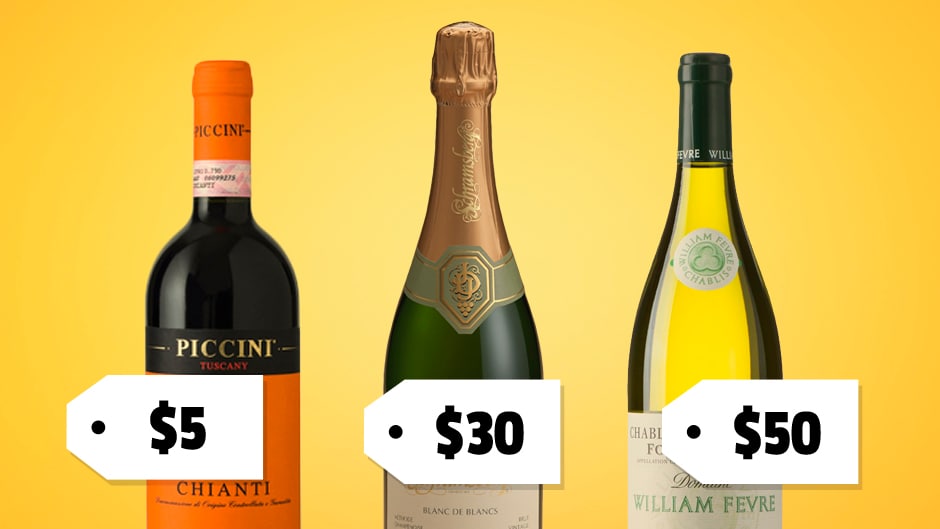
If you answered $90, you are only partially right. You can spend a widely varying amount on a bottle of wine, from a bottle of Barefoot wine at under $5.00 to a bottle of of Chateau Petrus at nearly $5,000. They are both wine, made from grapes, so what causes this difference? And what goes into the costs? It turns out it starts from the very ground the grapes are grown on and goes from there.
Land – the first element of cost in any wine is the land that the grapes are grown on. Inexpensive wine is grown in large plots of very inexpensive land. A few years ago, land in the premium wine growing region of Burgundy in France for Grand Cru vineyards was going for around $5 million an acre. The land in the Central Valley of California that is used to grow value wine is a fraction of this.
Grapes – the grapes that are used for the wine are also important and particularly the yield of the grapes in tons per acre. Some grapes are notoriously lower yielding, while inexpensive wines would use hearty grapes that can resist almost anything and still yield lots of juice.
Vineyard Management – the structure of the vineyard, including spacing and irrigation also play into the yield of the grapes. If you want perfect grapes for an expensive wine, there will be plenty of airflow and sunlight for your little darlings. Regular hand pruning of the vines is necessary to remove poor clusters and remove leaves that are excessively shading the grapes. Bulk wine operations do no hand pruning.
Harvest – Collecting the fruits of your hard work during the growing season is critical to the fruit that goes into the wine. Premium grapes are hand harvested when they are at the peak of ripeness. This can mean multiple passes through the vineyard, selecting only those clusters that are ready. They are then carefully handled to prevent bruising of the fruit on the way to the crushers. Large scale operations might make a single pass through the vines using machines to harvest the grapes and haul them away in bulk containers. Premium estates might yield 2 tons of grapes or less an acre with bulk wines yielding many times this amount. A ton of grapes yields around 720 bottles of wine, so that’s only 1,440 per acre – with some super premium wines well below this figure. As an example, you can buy grapes grown for bulk wine at $340 a ton, while a ton of premium Napa Cabernet Sauvignon grapes will set you back over $5,600 or almost $8 a bottle for the grapes alone.
Squeezing – Once the grapes have been harvested, the juice is pressed out. The first pressing or free-run is the juice that comes out with the first gentle squeeze of the grapes. Bulk wines will press much harder and many times to extract every drop of juice from the grapes they have. Some premium wines will use the second pressing to make a lesser wine that they will sell under a different name.
Oak – Most premium red wines are aged in oak barrels to impart tannins and a depth of flavor to the wine. These barrels don’t come cheap! New American oak might cost $1,000 for a smaller 225-liter barrel and around $2,500 for a new French oak barrel of the same size. This is another $8 for the oak. These barrels fit around 300 bottles of wine and in some premium makers are not used a second time for premium wines!
The grape juice, once pressed, will spend 18-24 months being converted into the wine the producer wants to sell and during this time, they still have to pay for the building, rent, insurance, lighting and so forth. Bulk operations look more like a chemical plant with stainless steel plumbing and a relatively short residence time in the winery.
Bottle, Cork & Label – Everyone knows that a great label and bottle can help sell a wine. For a bulk wine, this means a thinner bottle with a cute label and an inexpensive seal, perhaps screwcap. Premium wines will have elegant labels, sometimes with original artwork from a famous artist, a heavy glass bottle designed to hold up for extended cellaring and a premium cork with tight structure and extra length. The bottle can easily run $3-4 and the cork another $3.
Labor – We haven’t really talked about all the labor required to run a vineyard, from the farmer, the pruners and the harvesters. Once inside the winery, there is production help and a very expensive winemaker in the middle. Since everyone needs certain types of talent at the same time of the year, like harvest time, the price for their services gets bid up substantially.
Marketing – Finally, we get to the X-factor, marketing. Any good marketer will tell you that there isn’t a correlation between price and cost. Price is set by the market and what people will pay. While the bulk wine companies are focused on the lower end of the market and price that way, the premium producers go over the top on every element of the wine making process. When they finally set price, the market demand and the perception of the wine come into play.
No matter the costs they have put into the bottle, the market will set the price – and sometimes that price can make you dizzy!
Cheers!

